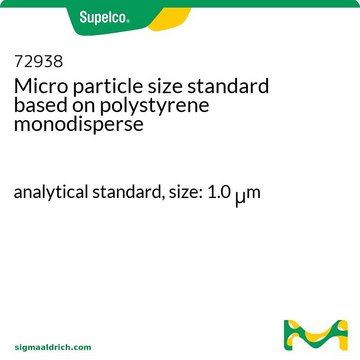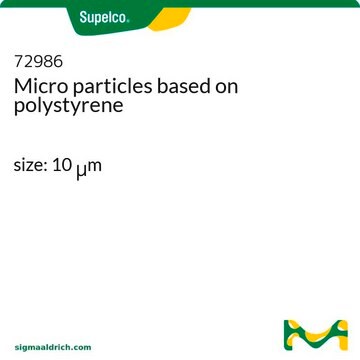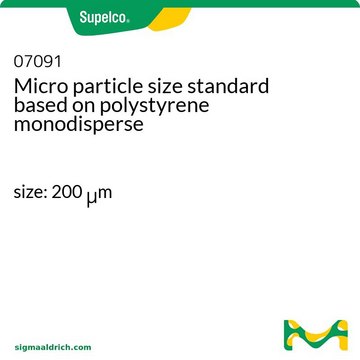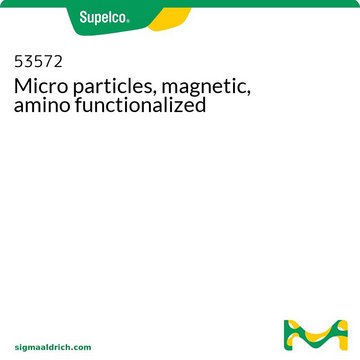59769
Micro particles based on polystyrene
size: 500 nm
Sinónimos:
Latex beads from PS
Iniciar sesiónpara Ver la Fijación de precios por contrato y de la organización
About This Item
Productos recomendados
formulario
aqueous suspension
concentración
10% (solids)
tamaño de partícula
500 nm
densidad
1.05 g/cm3
temp. de almacenamiento
2-8°C
¿Está buscando productos similares? Visita Guía de comparación de productos
Categorías relacionadas
Descripción general
Micro Particles or Latex Beads, commonly known as polystyrene microparticles, are negatively charged colloidal particles. The microparticles are produced through a polymerization reaction of styrene under controlled conditions. The conducive environment of the reaction induces spontaneous coalescent bead formation. Micro Particles or Latex beads are supplied in aqueous solutions composed of polymer particles with water. Polystyrene′s refractive index at 589 nm is 1.5905 and 1.602 at 486 nm.
Aplicación
Micro Particles or Latex Beads is used for a wide variety of applications like:
- Electron Microscopy.
- Cell Counter Calibration.
- Immunodiagnostics, especially for latex agglutination tests, and
- Phagocytosis Research.
Nota de análisis
For every lot exact values of particle size and standard deviation are determined with an accuracy of 0.01 μm using a Coulter Multisizer.
Código de clase de almacenamiento
10 - Combustible liquids
Clase de riesgo para el agua (WGK)
WGK 3
Punto de inflamabilidad (°F)
Not applicable
Punto de inflamabilidad (°C)
Not applicable
Equipo de protección personal
Eyeshields, Gloves
Certificados de análisis (COA)
Busque Certificados de análisis (COA) introduciendo el número de lote del producto. Los números de lote se encuentran en la etiqueta del producto después de las palabras «Lot» o «Batch»
¿Ya tiene este producto?
Encuentre la documentación para los productos que ha comprado recientemente en la Biblioteca de documentos.
Los clientes también vieron
Shunmugaperumal Tamilvanan et al.
PDA journal of pharmaceutical science and technology, 62(3), 177-190 (2008-07-30)
The objective of this study is to select a multiple-unit sustained-release formulation and to compare it with both commercial immediate and single unit sustained-release capsules and also to determine whether an in vitro-in vivo correlation exists for single- and multiple-
Elizabeth M Walker et al.
Journal of colloid and interface science, 363(1), 307-313 (2011-08-16)
We have studied polydimethylsiloxane (PDMS)-in-1-butyl-3-methylimidazolium hexafluorophosphate ([BMIM][PF(6)]) Pickering emulsions stabilized by polystyrene microparticles with different surface chemistry. Surprisingly, in contrast to the consensus originating from oil/water Pickering emulsions in which the solid particles equilibrate at the oil-water droplet interfaces and
Fiona A Sharp et al.
Proceedings of the National Academy of Sciences of the United States of America, 106(3), 870-875 (2009-01-14)
Many currently used and candidate vaccine adjuvants are particulate in nature, but their mechanism of action is not well understood. Here, we show that particulate adjuvants, including biodegradable poly(lactide-co-glycolide) (PLG) and polystyrene microparticles, dramatically enhance secretion of interleukin-1beta (IL-1beta) by
Sensitive Mie scattering immunoagglutination assay of porcine reproductive and respiratory syndrome virus (PRRSV) from lung tissue samples in a microfluidic chip.
Song JY, Lee CH, Choi EJ, Kim K, et al.
J. Virol. Methods, 178, 31-38 (2011)
Nuestro equipo de científicos tiene experiencia en todas las áreas de investigación: Ciencias de la vida, Ciencia de los materiales, Síntesis química, Cromatografía, Analítica y muchas otras.
Póngase en contacto con el Servicio técnico










